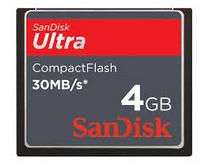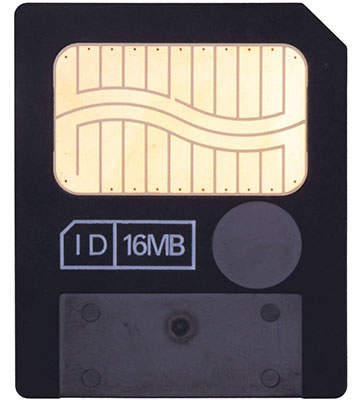Storage media are storage devices like CF card, SD card, MMC card and Memory Stick that store files and data. The most popular storage media are based on the Nand-flash, including USB disk, CF card, SD card, SDHC card, MMC card, SM card, Memory Stick, xD card, etc.
CF Card

Compact Flash (CF) card, a flash memory mass storage device, was first introduced by SanDisk in 1994. It is compatible with PCMCIA-ATA card. And it is a solid product weighing 14g, and it does not require moving parts when it begins to work. CF card adopts flash memory technology which is a stable storage solution that does not require a battery to maintain the data stored in this card.
Advantages
CF card has a better protection for its data than tradition disks. And its reliability is 5-10 times as much as the tradition disks’. Besides, CF card can work well with 3.3 V to 5V voltages. Therefore, most digital cameras choose CF card as its preferred storage media.
CF card not only can ensure the compatibility of its product but also can guarantee its backward compatibility. Since the CF card is applied more and more widely, the manufactures make great advancement in technology to promote a new generation of lightweight body and lower energy consumption CF card to improve work efficiency. CFA is headquartered in Palo Alto, Canada, and its members can receive a free CF card, CF trademarks and technical details. CFA members include 3COM, Canon, Kodak, HP, Hitachi, IBM, Panasonic, Motorola, NEC, SanDisk, Seiko, etc. And, the major camera manufactures have set up a special program to research and develop CF products.
Disadvantages
- Capacity is limited. Although its capacity doubled, it cannot keep up the development of digital camera. The minimum specification of the popular high-end products is 5 megapixels. And the civilian mainstream market has reached 3 megapixels.
- Volume is large. Compared with other types of memory card, the volume of CF card is slightly larger. Thus, most popular ultra-thin digital cameras would like to use SD card instead of CF card.
Currently, the world’s largest capacity a CF card supports has reached 256GB, and manufacturers have stopped producing 8/16/32/64/128/256MB CF cards. At present, the minimum capacity of CF card is 1GB.
SM Card
Smart Media card was released by Toshiba in November of 1995, and Samsung bought the production and sale licenses. Therefore, the two companies become the major SM card vendors. In order to promote the smart media to become the industry standard, SSFDC Forum has been established in April 1996.

SM card is 37mm × 45mm×0.76 mm in size. It is very thin and small since it doesn’t have control circuit. Before 2002, it was widely used in the digital cameras, such as the old Olympus digital cameras as well as the old Fuji digital cameras. However, SM card control circuit is integrated into digital products (like digital camera), so the compatibility of digital products is susceptible.
The new digital cameras have not adopted SM card products.
Memory Stick
Memory stick is a removable flash memory card, launched by Sony. Almost all Sony audio and video products can use this storage device. Besides, memory stick has a wide range of comprehensive feature. And, it has other good features such as high compatibility, “universal media”, high stability, and copyright protection.
In addition, Sony has developed lots of products like DV camcorders, digital cameras and VAIO personal computers to use memory stick. What’s more, memory stick can be easily connected to PC and Macs.
After the introduction of memory stick, Samsung, Aiwa, Sanyo, Casio, Fujitsu, and other companies show support on this product. Sony will introduce more memory stick products in the domestic market.
The disadvantage of memory stick is that it can only be used in Sony digital camera. Besides, its capacity is not nearly big enough.
MICRoDRIVE
MICRoDRIVE is a large-capacity storage media, developed by IBM. Since there is no large-capacity storage media for digital camera, the development of digital camera was once hindered. Aiming at this situation, the IBM released the MICRoDRIVE which is consistent with the CF card type II interface. After more than a year of development, the capacity of MICRoDRIVE has reached 1GB.
Of course, it would be a little more expensive, but it is worth. In theory, as long as the digital camera supports the CF card type II interface, it will also support MICRoDRIVE. However, although some models such as the Epson PC-3000 adopt the type II interface, they cannot support MICRoDRIVE. Currently, QV3000EX, Canon PoWERShotS20 and G1 can support MICRoDRIVE.